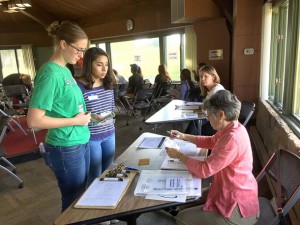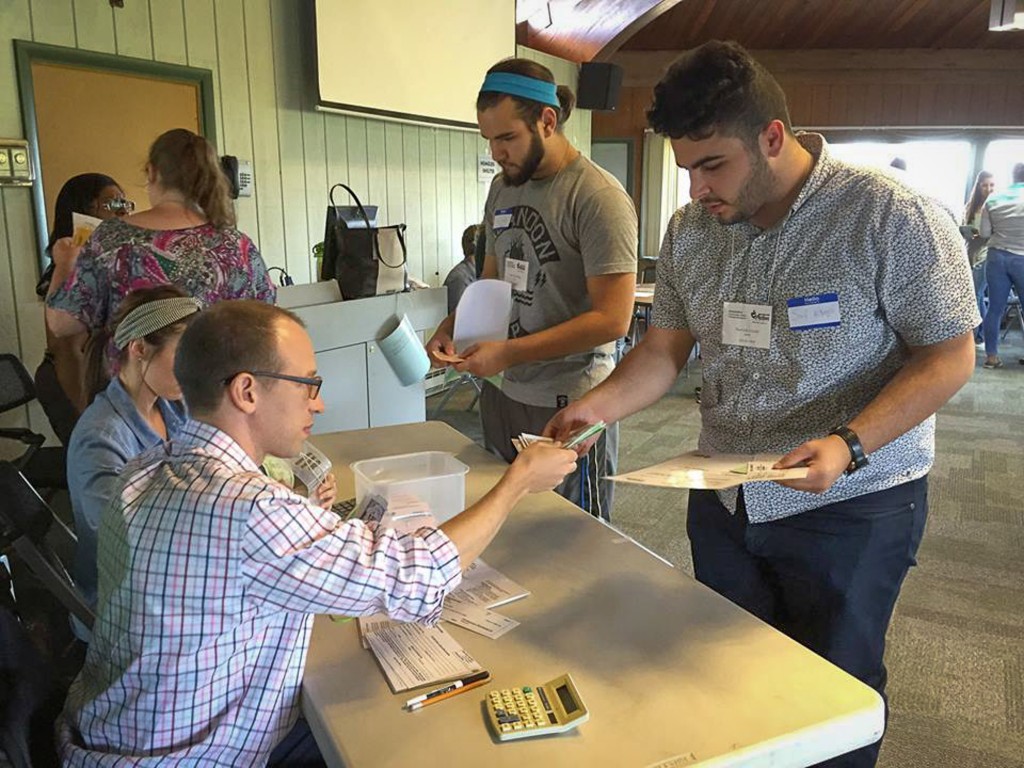“We started out in a bad situation, and nothing got better … I tried to go to work,” said the unmarried father of a one-year-old. Despite working full-time, he was unable to pay the mortgage and utilities, leading to eviction.
Suddenly the father found himself, his girlfriend, and his child in a homeless shelter. He had no money for transportation to seek help from social services. After two weeks, they were forced to leave the shelter as well – and once out on the streets, were picked up by the police and put in jail. The father was able to pay bail and return to the work force, leaving his family behind while he saved money.
“I figured since they had shelter and hot meals, and that was a better situation than being on the streets,” he explained.
The father was a character, played by student Kayley Argenbright, as part of the poverty simulations staged in late October at Eastern Mennonite University. More than 40 students participated.
“My goal for the event was for the students to have a better understanding of low income families and the struggles they deal with,” said Cristin Sprenger, a Virginia Cooperative Extension agent who coordinated the exercise with Celeste Thomas, student advisor for multicultural services. [To learn more about VCE poverty simulations, click here.]
Frustration, anxiety surface after activity

Students, grouped into “families” with specific obstacles and backgrounds, had to meet certain quotas of working, feeding their children, paying bills, meeting medical needs, and managing transportation by visiting different stations around the room. Every 15 minutes represented a week, with four weeks in the simulation followed by a debriefing.
Electronic Benefit Transfer (EBT) cards were filled and ran out, the pawn shop was booming in furniture but refused to buy microwaves, and the bank service was slow and swathed in red tape. Children were left in daycare when their parents could not afford transportation vouchers. Chairs, representing homes, were overturned with eviction signs – often illegally. Interfaith services had extra transportation, food, and clothing vouchers to disperse, but only two families were aware of that resource. The schoolteacher spoke only Spanish.
The simulation was realistic enough that in the debriefing, students voiced frustration and anxiety. Only one family paid for the minimum food necessary during all four weeks. Three people admitted to doing something “illegal.” No family paid their rent in full, on time, every time.
“It is never one thing at a time” that causes poverty, said volunteer Linda Martin Burkholder, an assistant in the cross-cultural program who acted as the Department of Social Services. “Things layer up.”
Burkholder came to her role with life experience: the impoverished people she met while working in a community development agency were beset by several misfortunes at once – disabilities, injuries, teenage pregnancies, car failures.
Sprenger wanted students to be realize that this “layering-up” effect can happen to anyone. “My hope is that they will take this experience with them as they enter the workforce and be understanding of the people that they work with in the community.”
Difficult choices

Nursing student Rebecca Powell, who played a young homeless mother, said that the simulation brought these common difficulties to life. “In the future I hope to be able to make a difference and touch the lives of the patients that I encounter by delving into their personal lives,” said Powell, “seeing them … in a more holistic view – spiritually, mentally, physically, socially.”
Ry Bergum, also of the nursing program, played the father struggling to care for his family and a mother-in-law. Bergum comes from a background in which this is not uncommon, but saw the impact of this exercise on his classmates’ faces.
“The vast majority of the time, it is not a red or a blue issue,” said Bergum about the tendency to view poverty in terms of policy rather than people. But, he explained, when poverty is seen only as a partisan issue, “the victims in that are the impoverished people in our society.”
“It is real life,” answered Sprenger. “People make the best decisions that they can. Sometimes they’re choosing between food and medication.”
And in that case, Kayley Argenbright added, “There’s no right thing to do [in that situation].”
